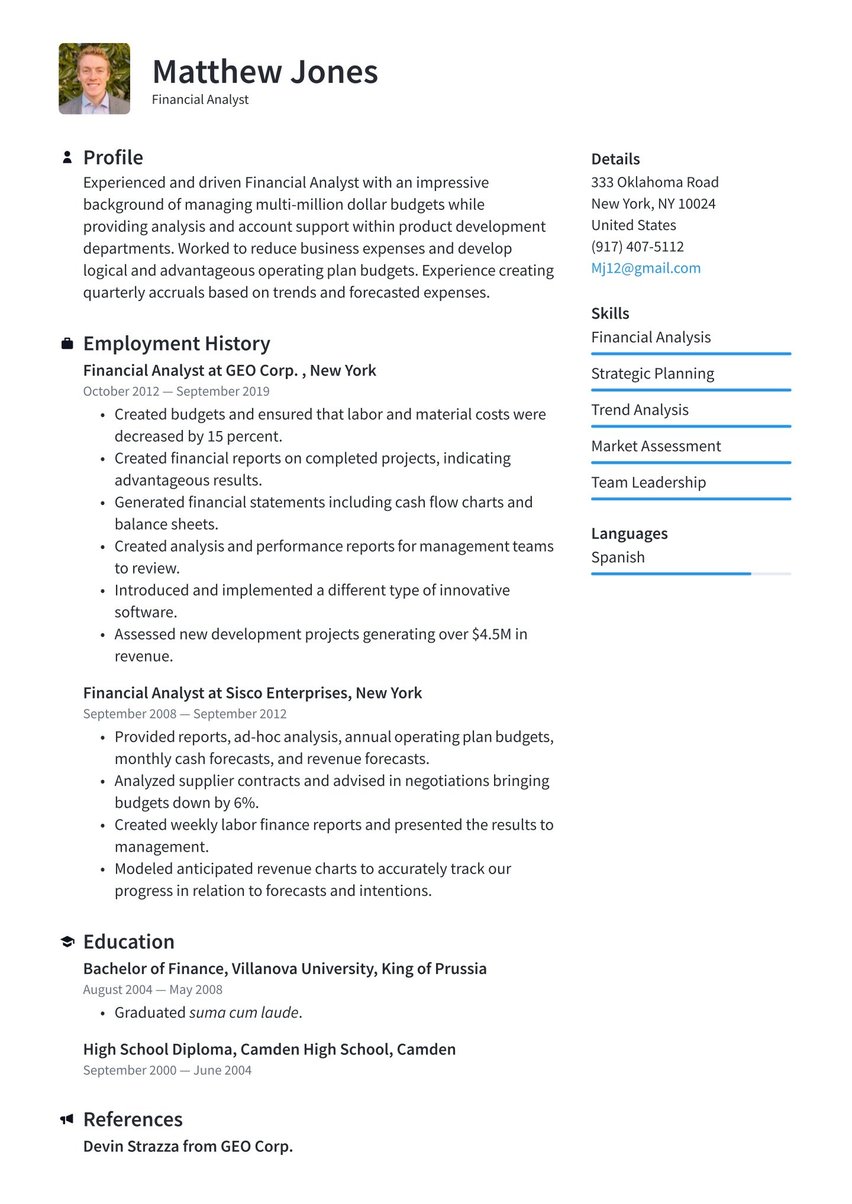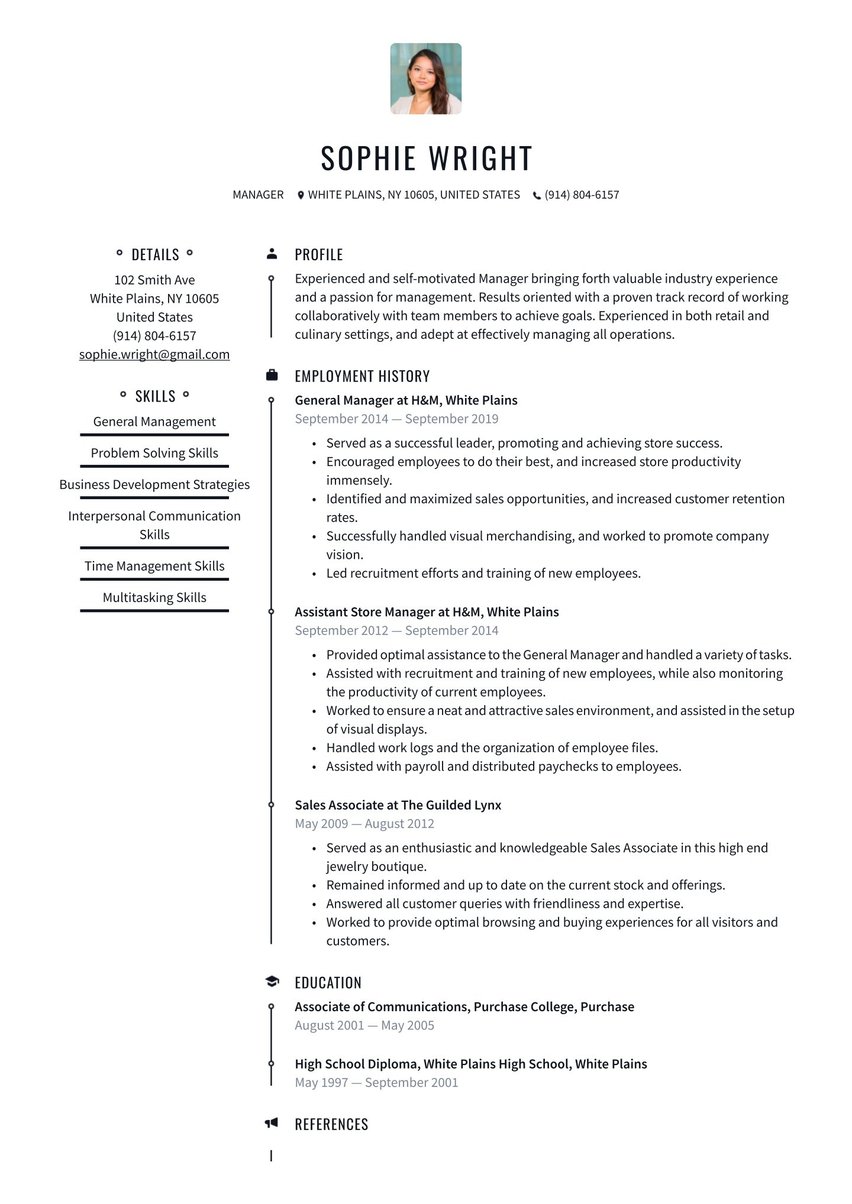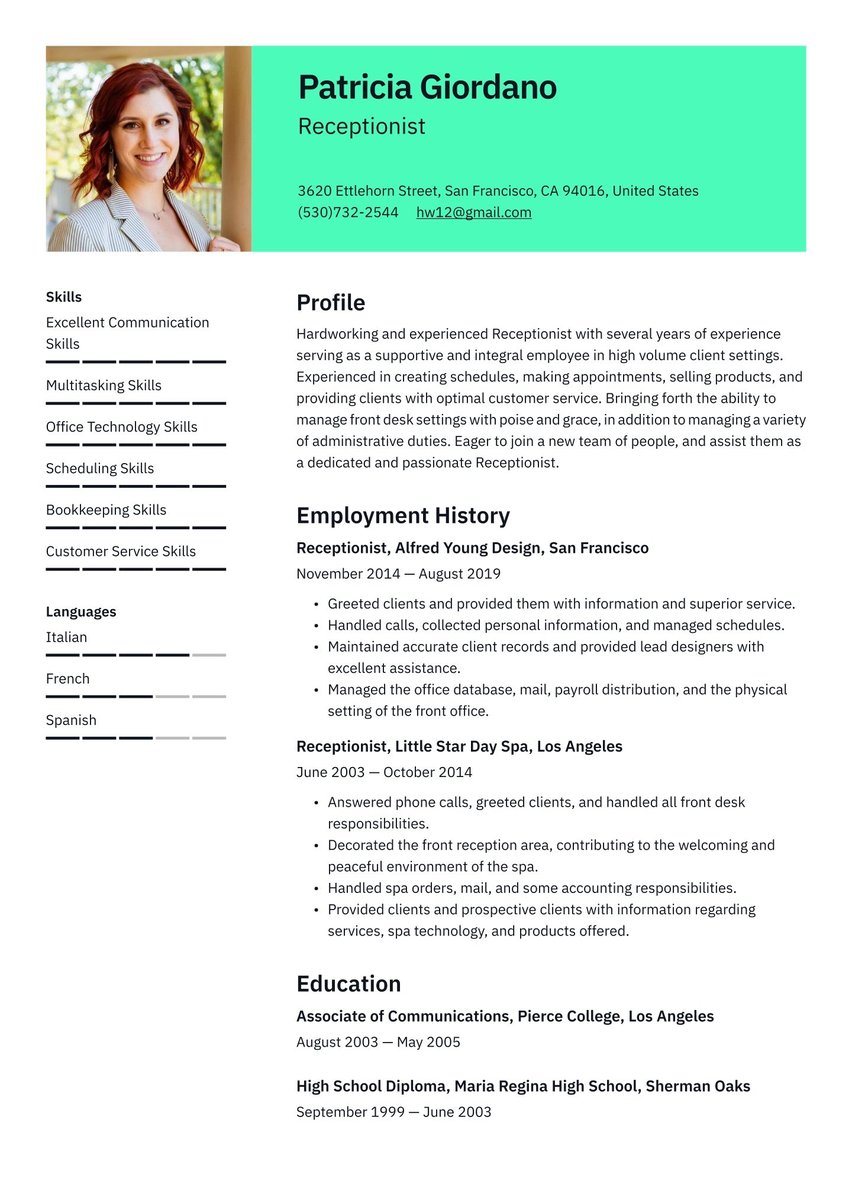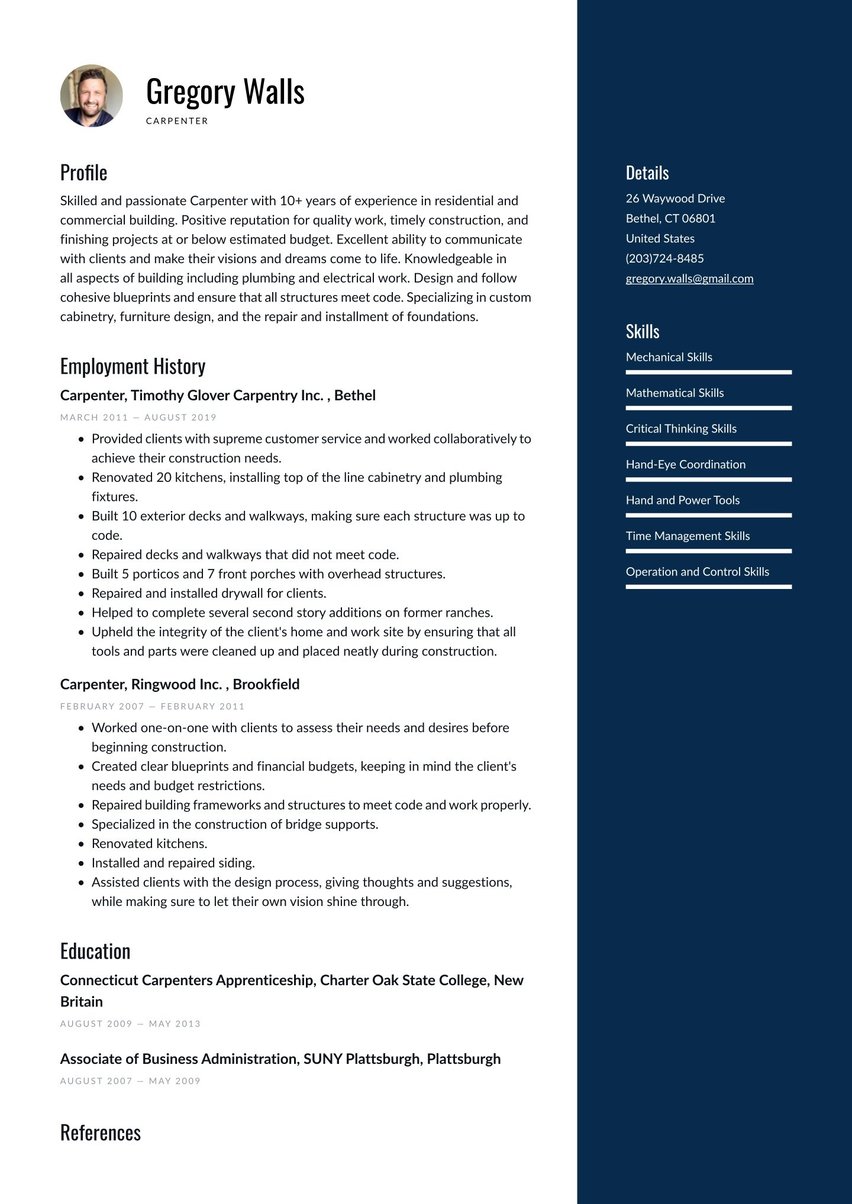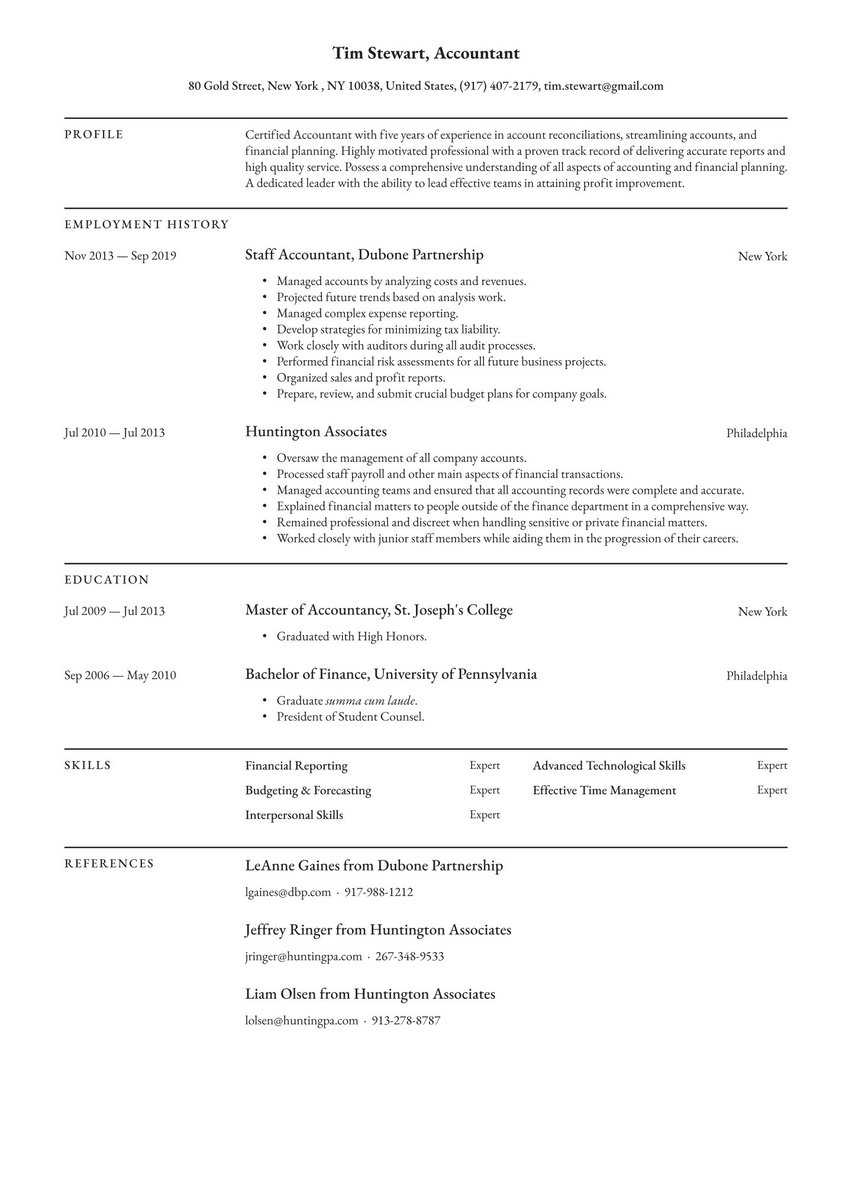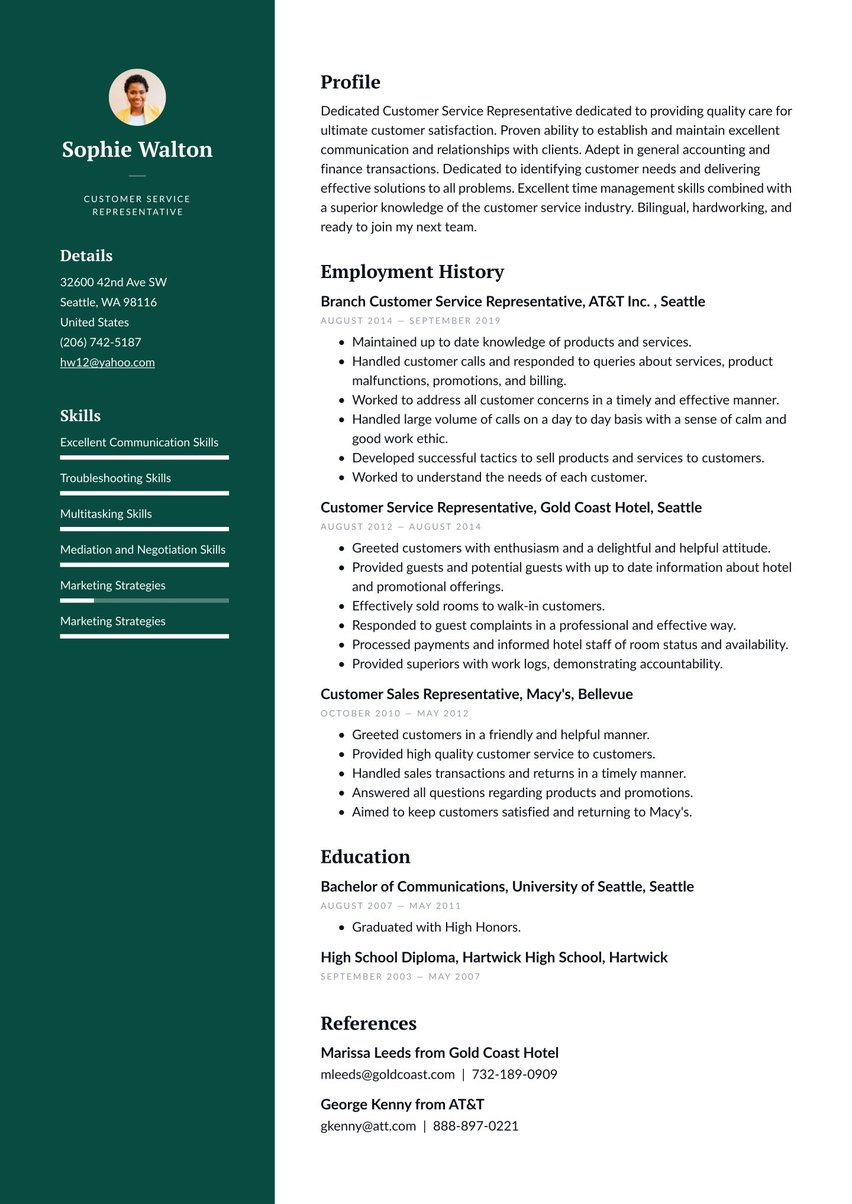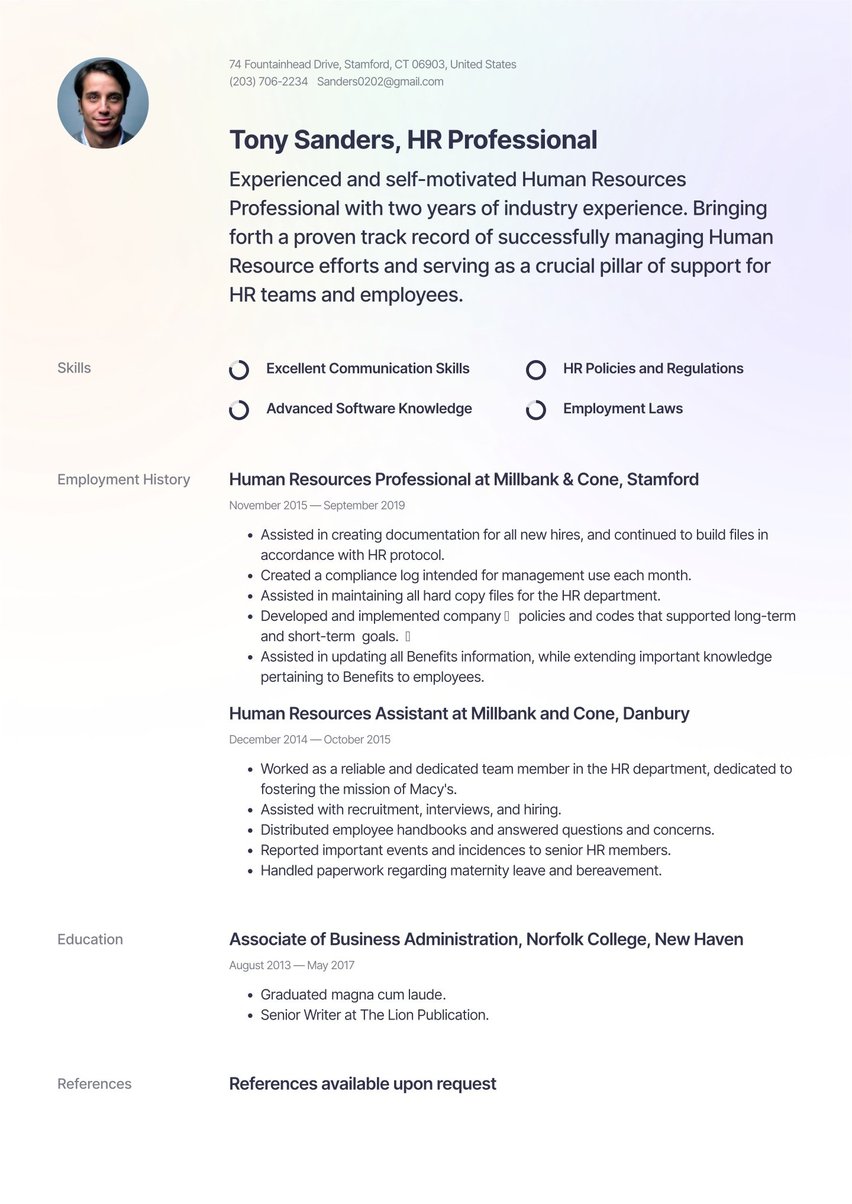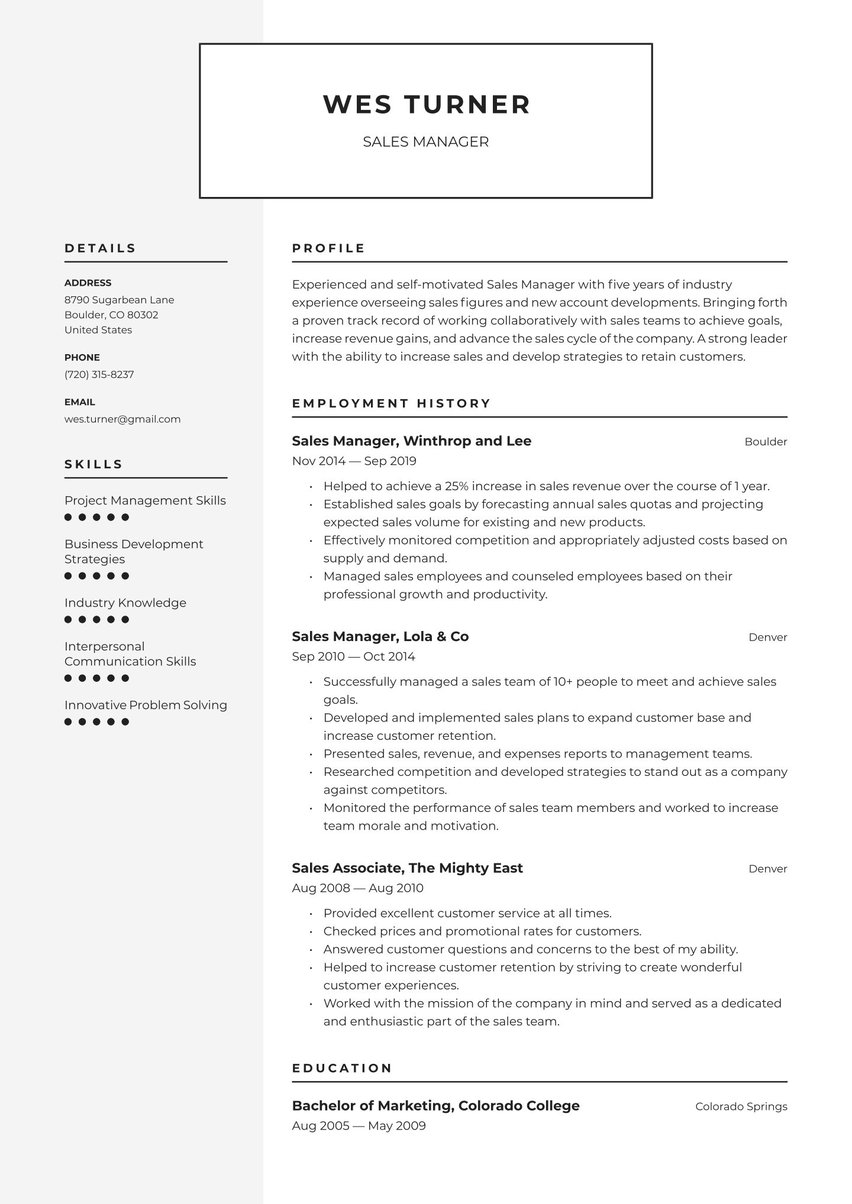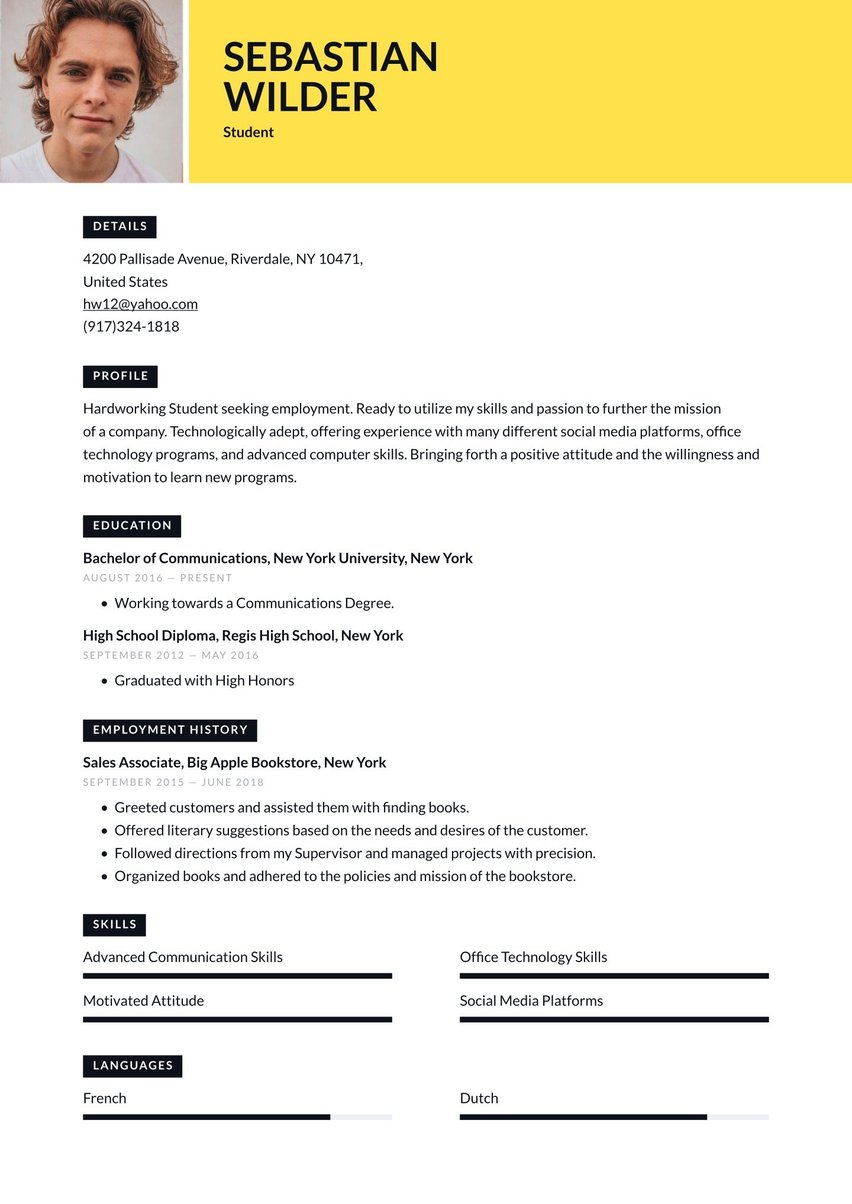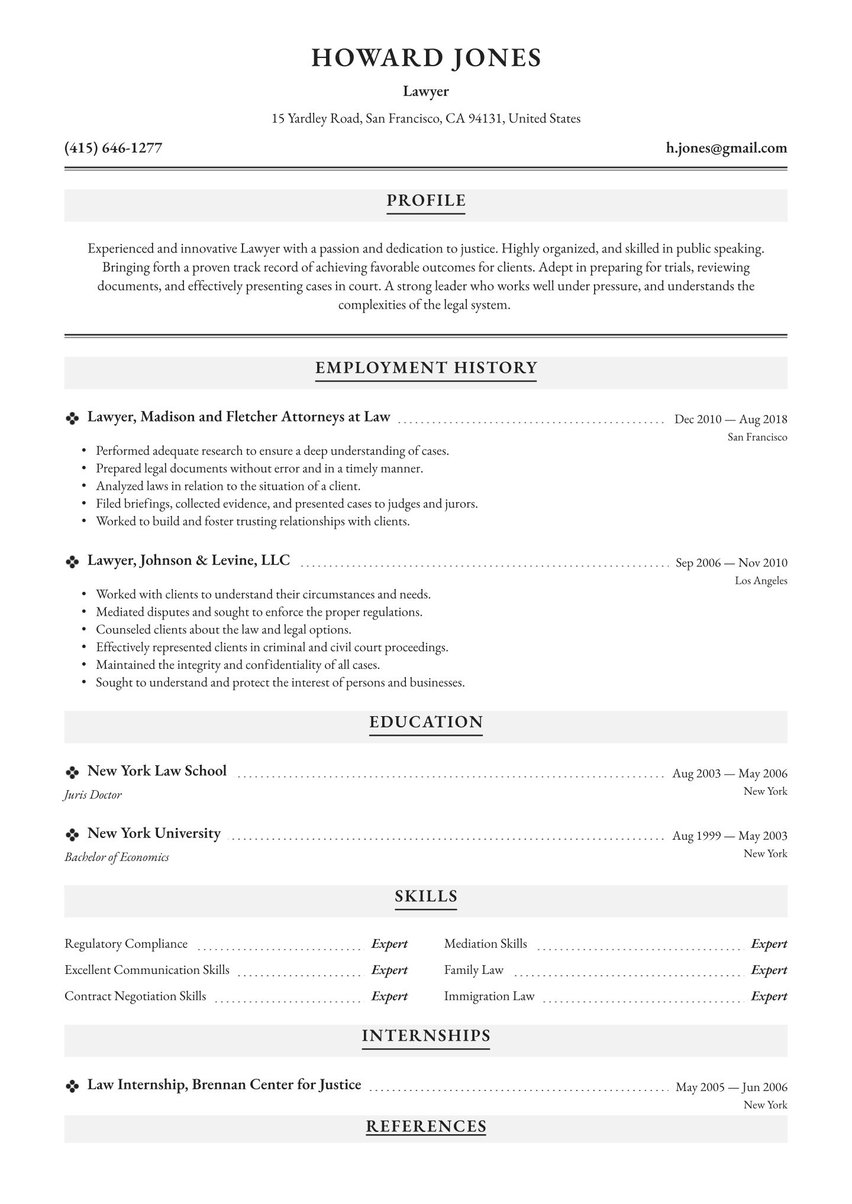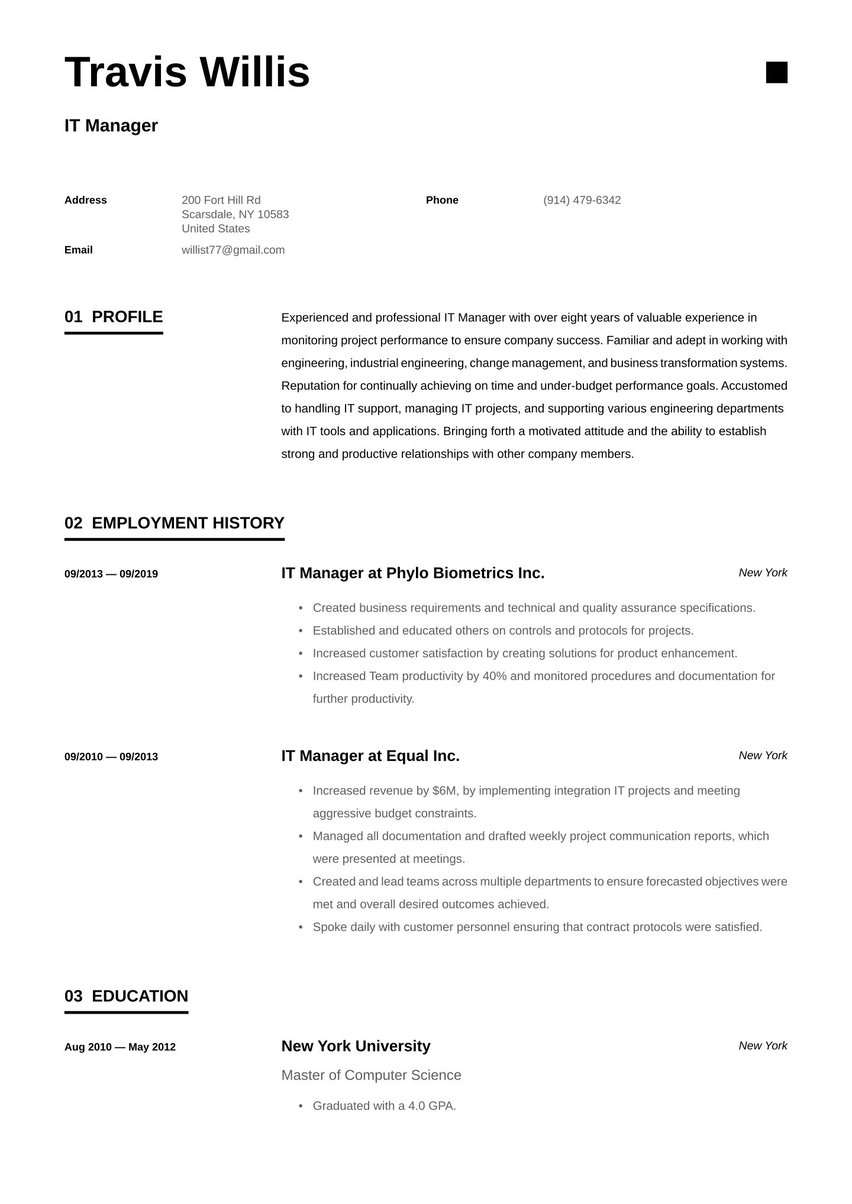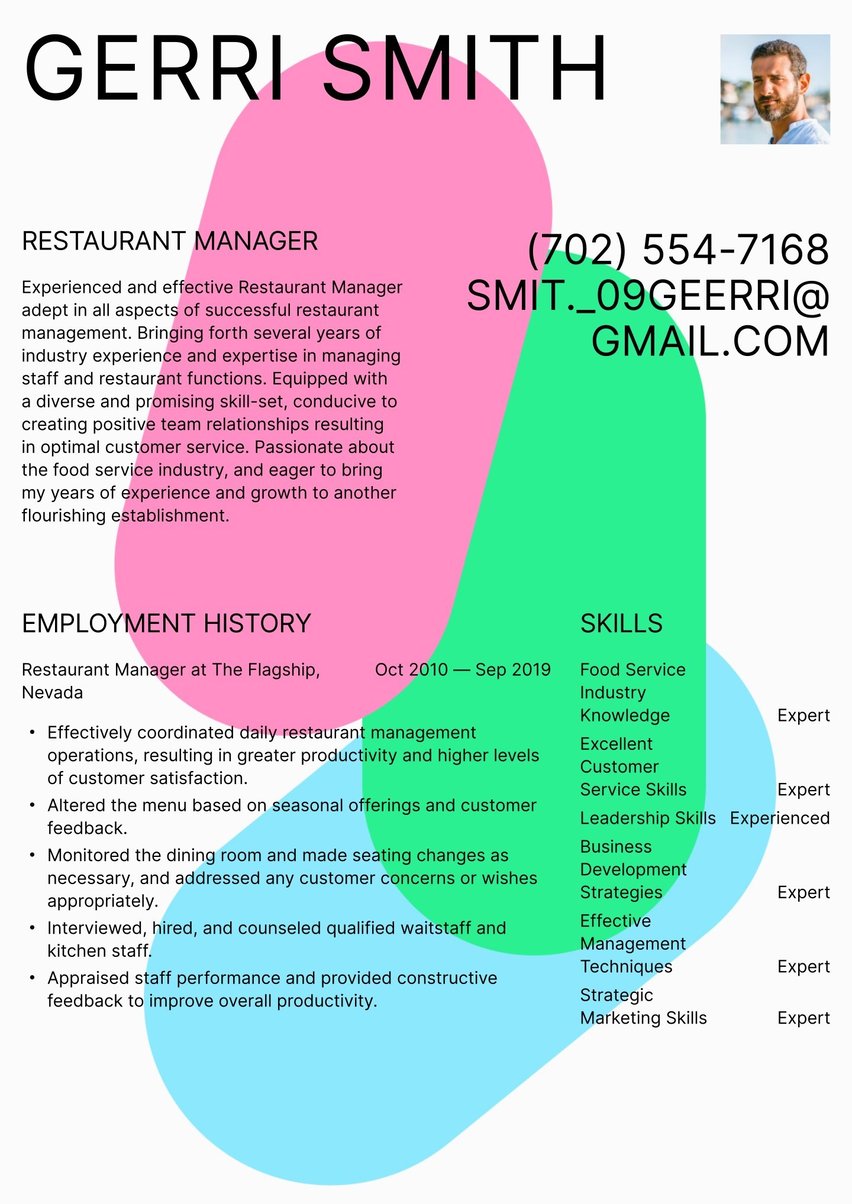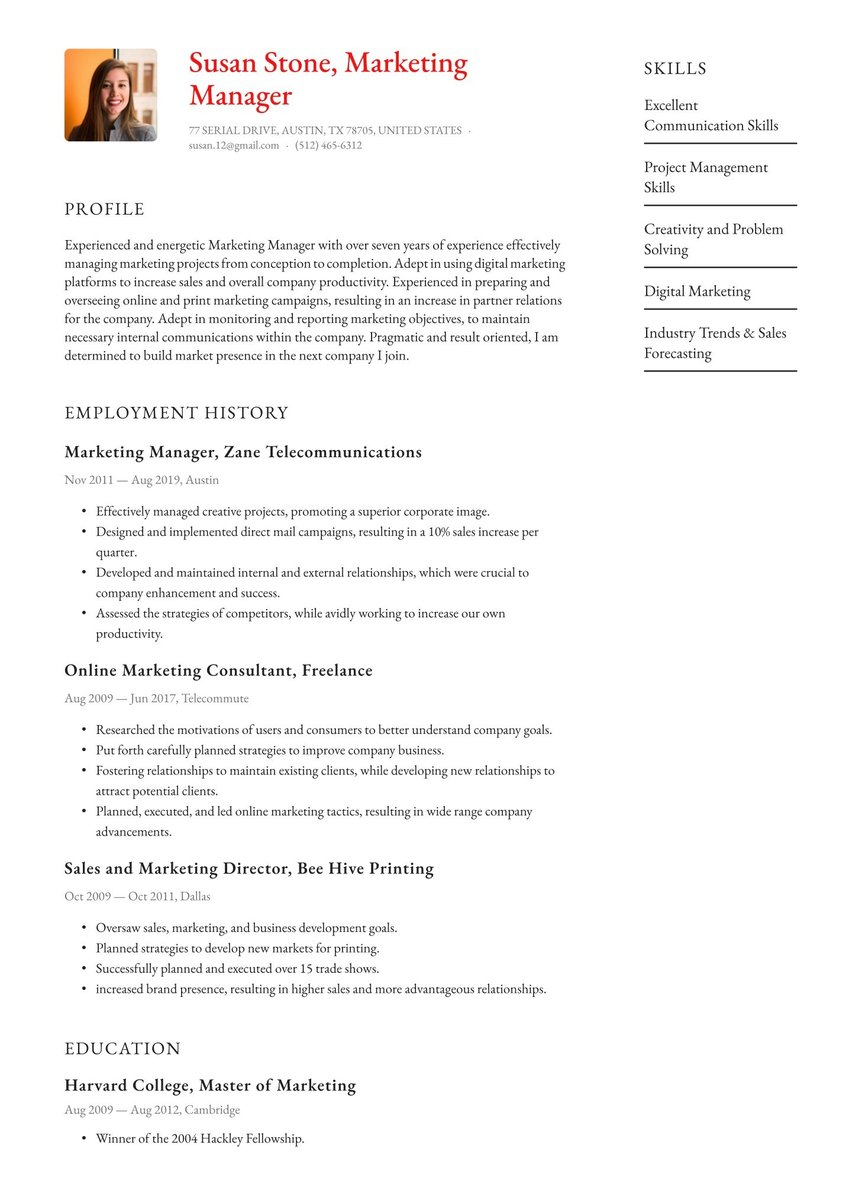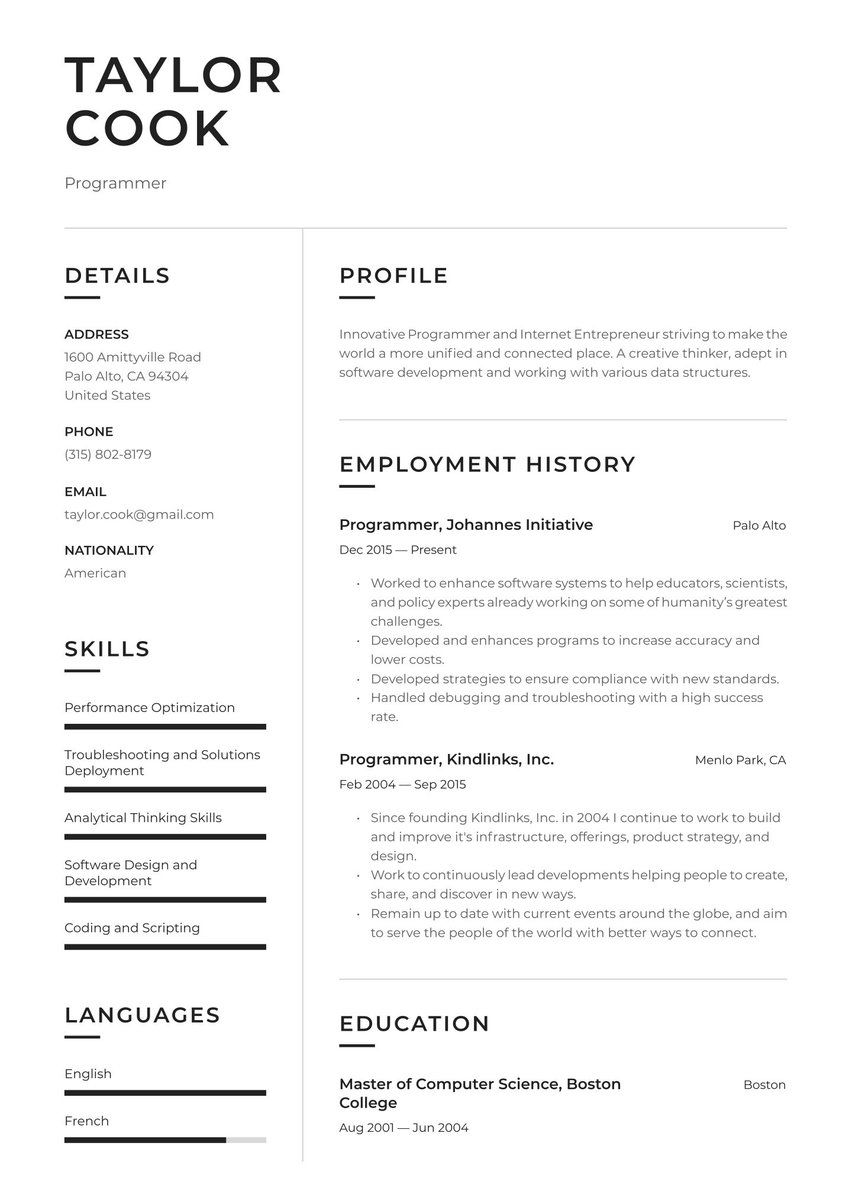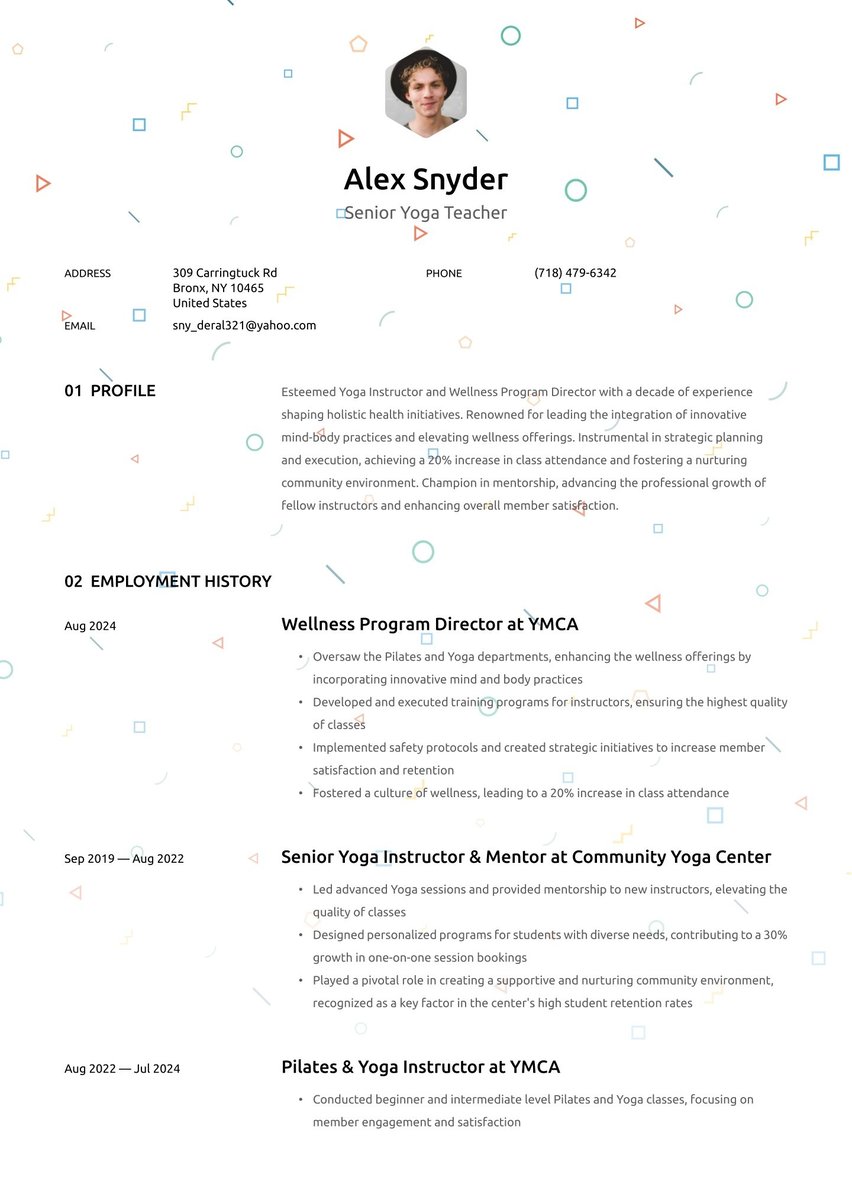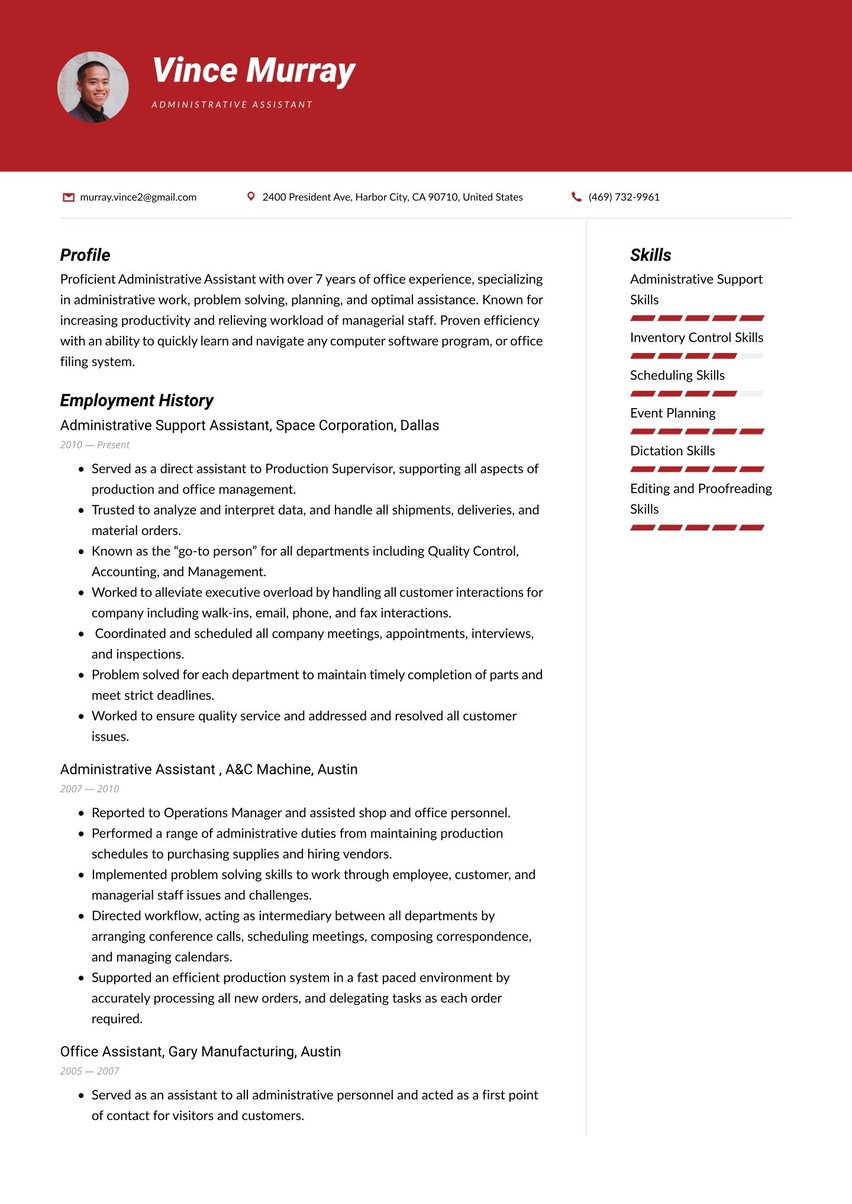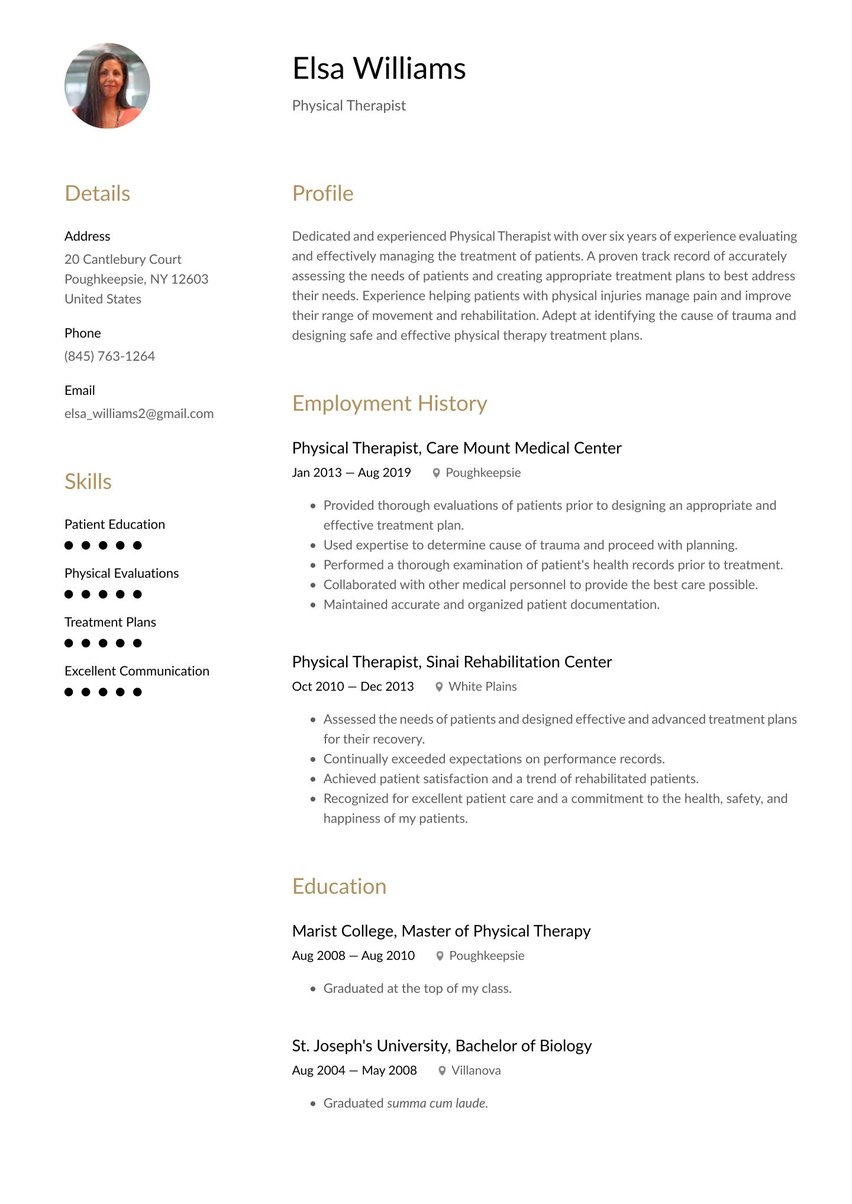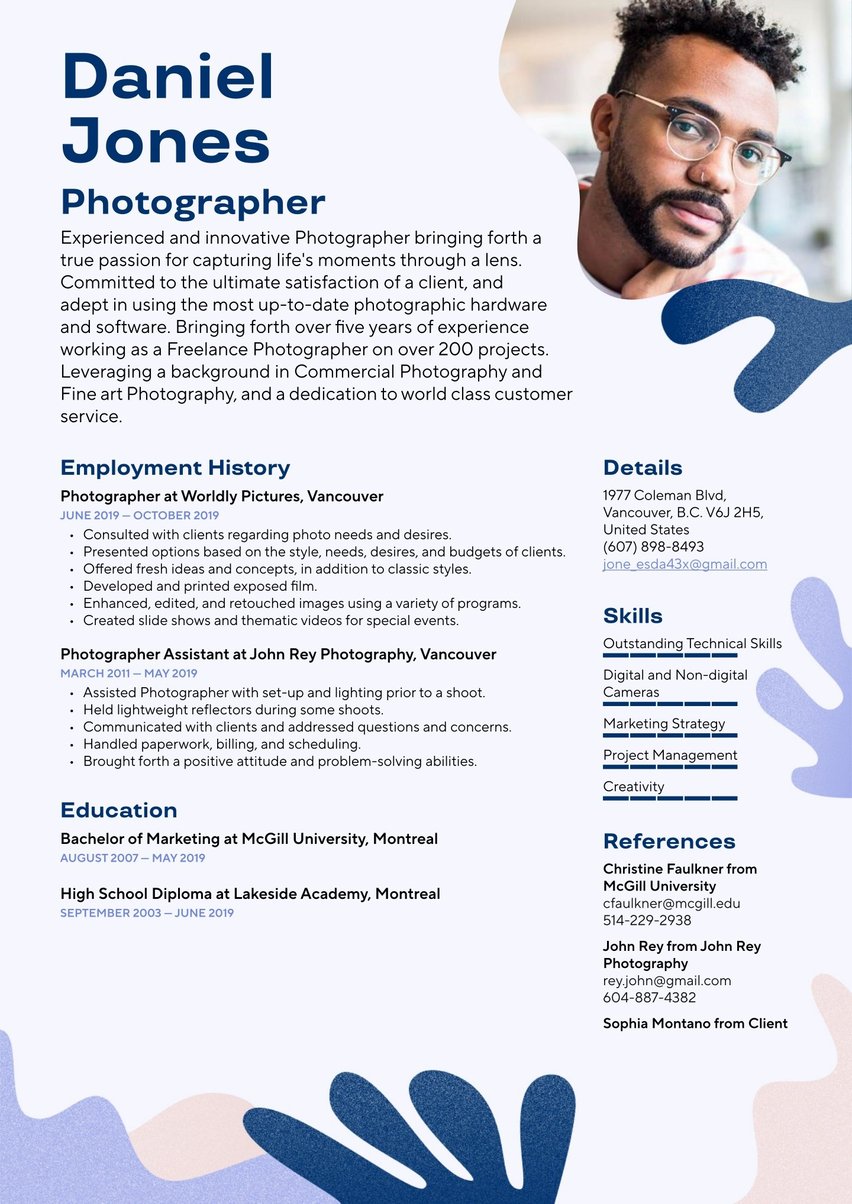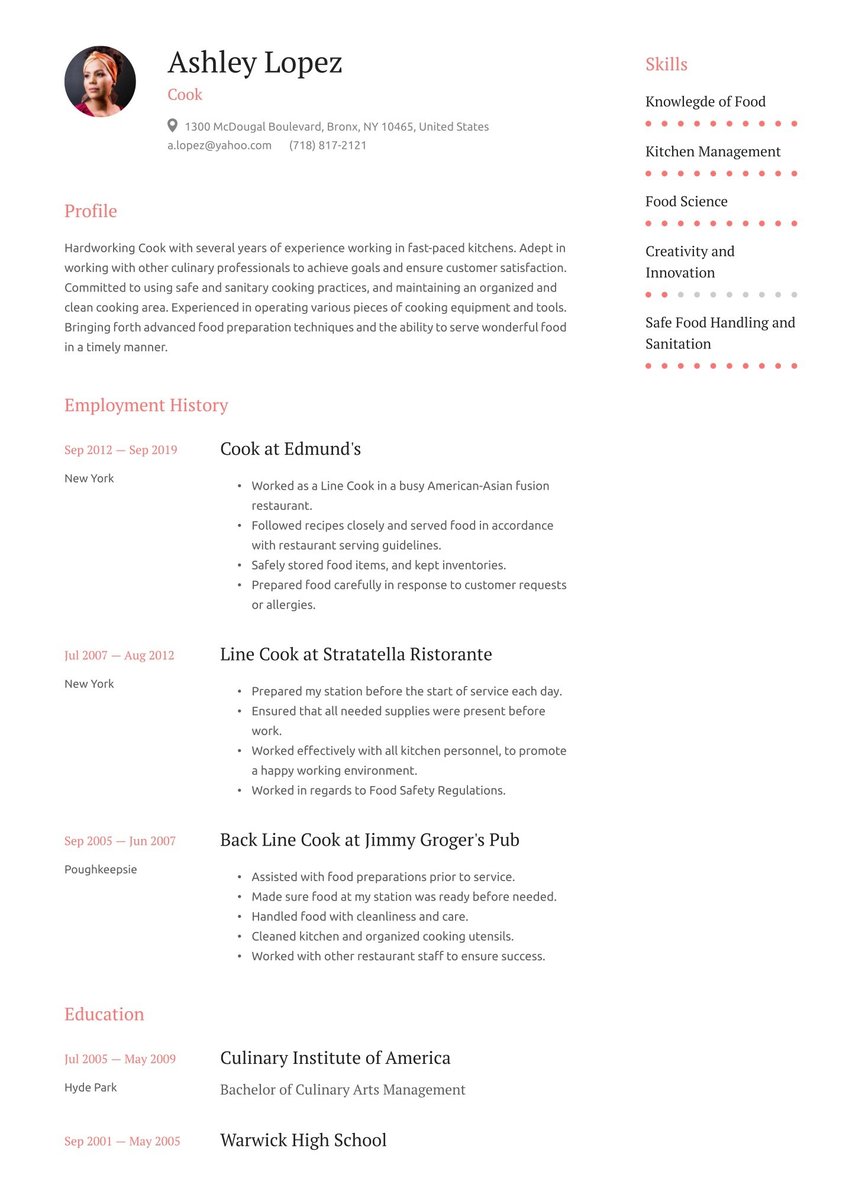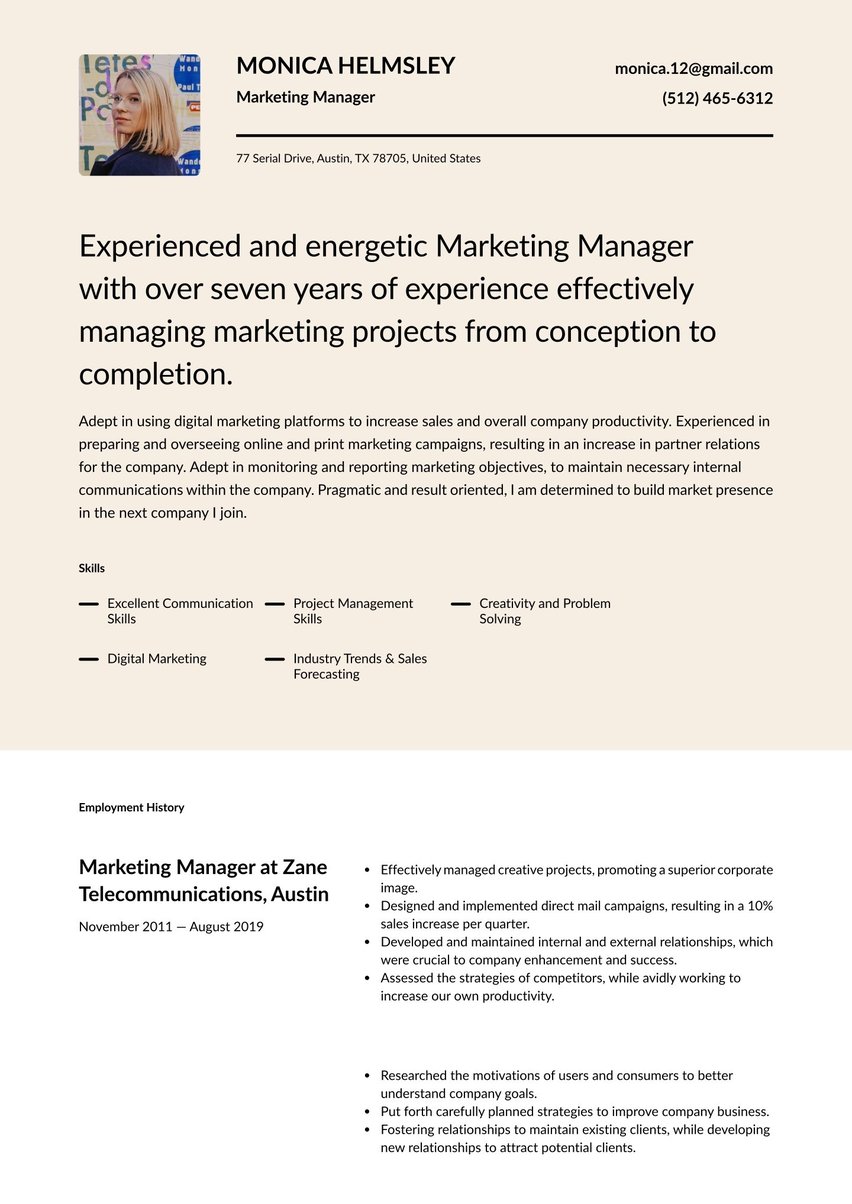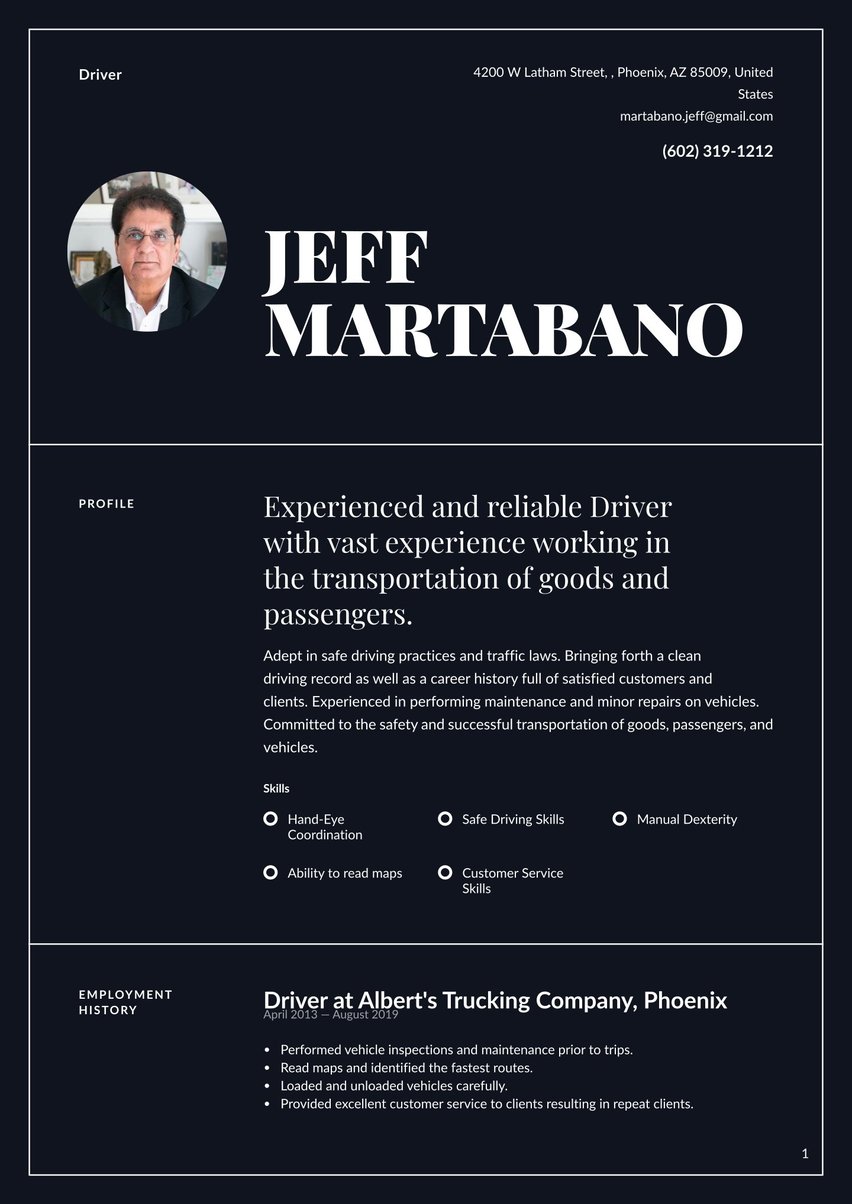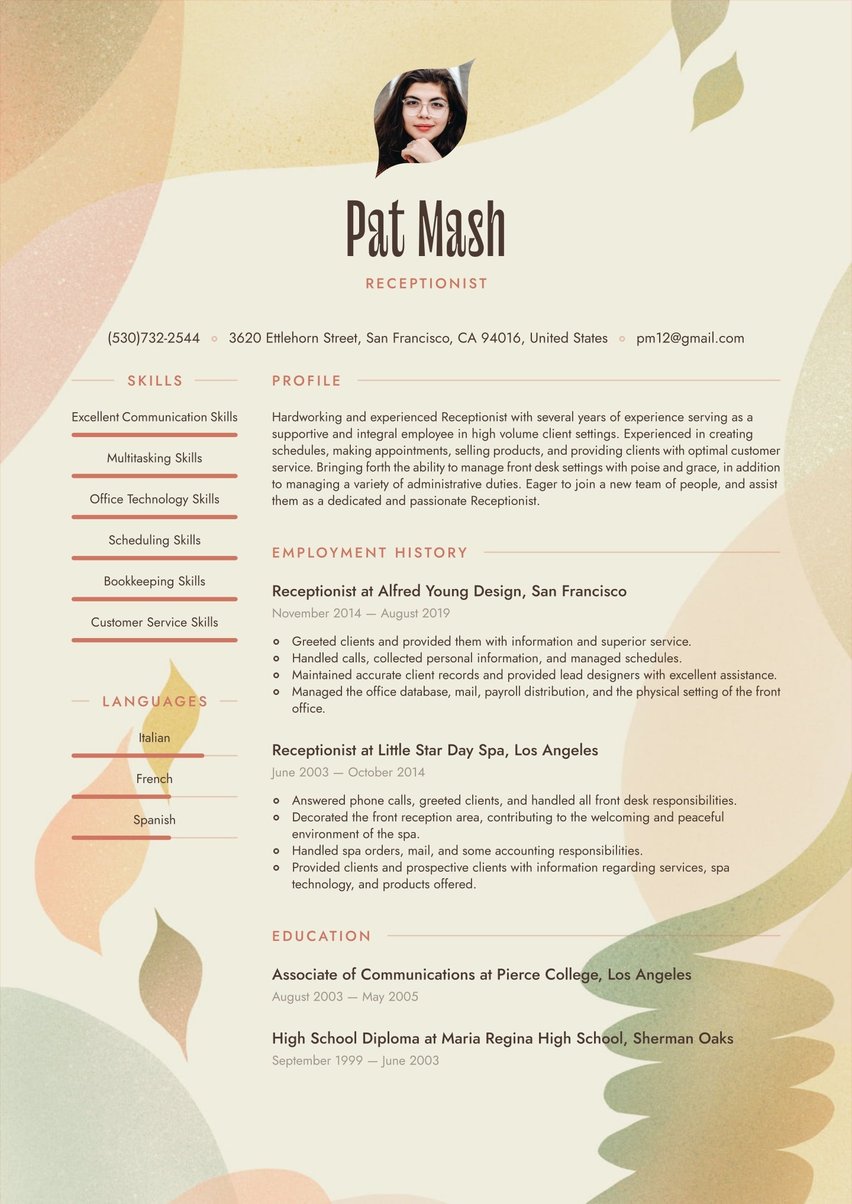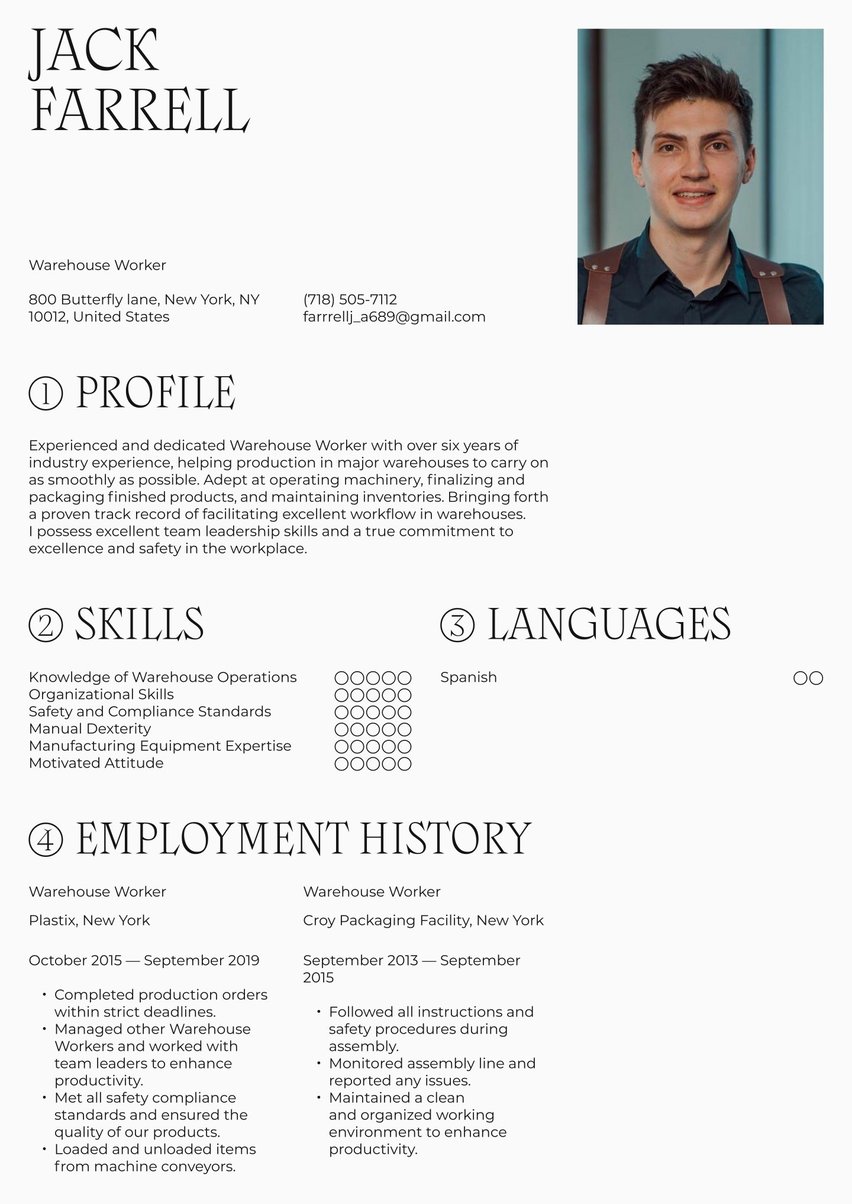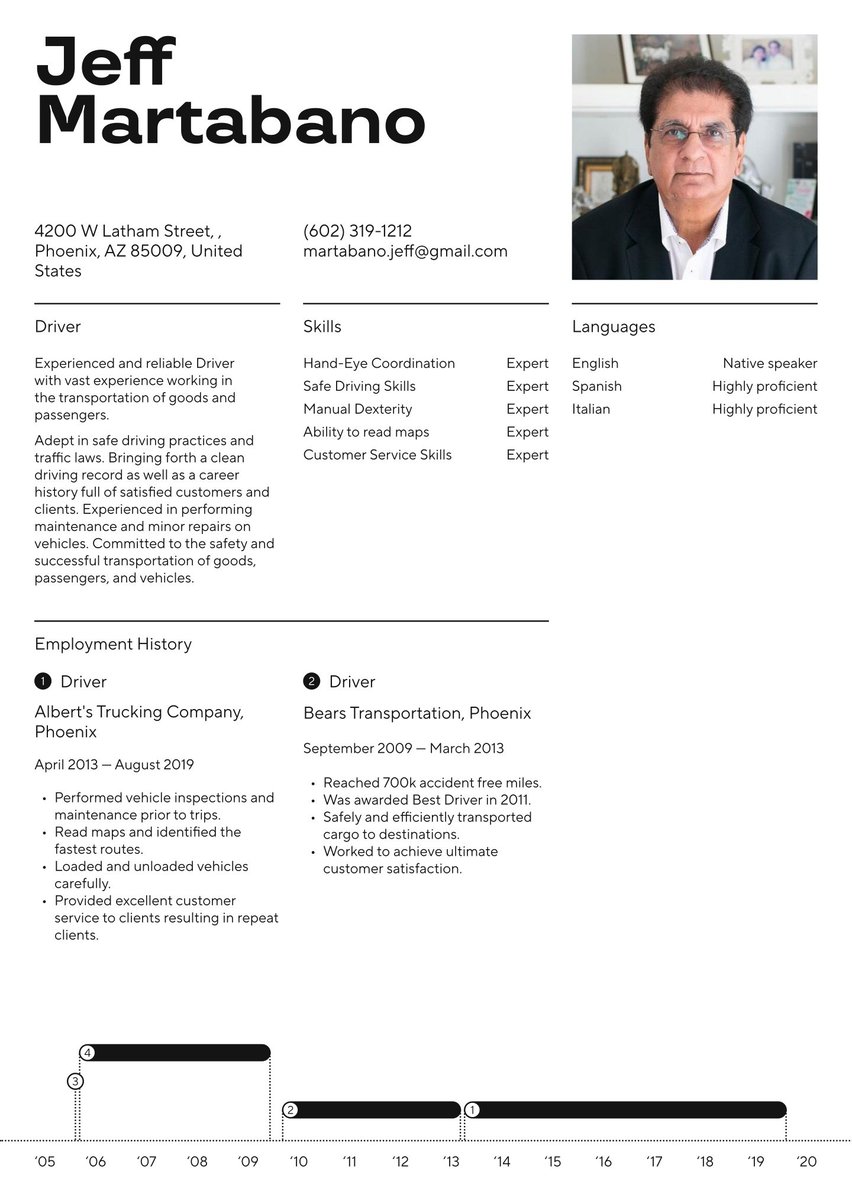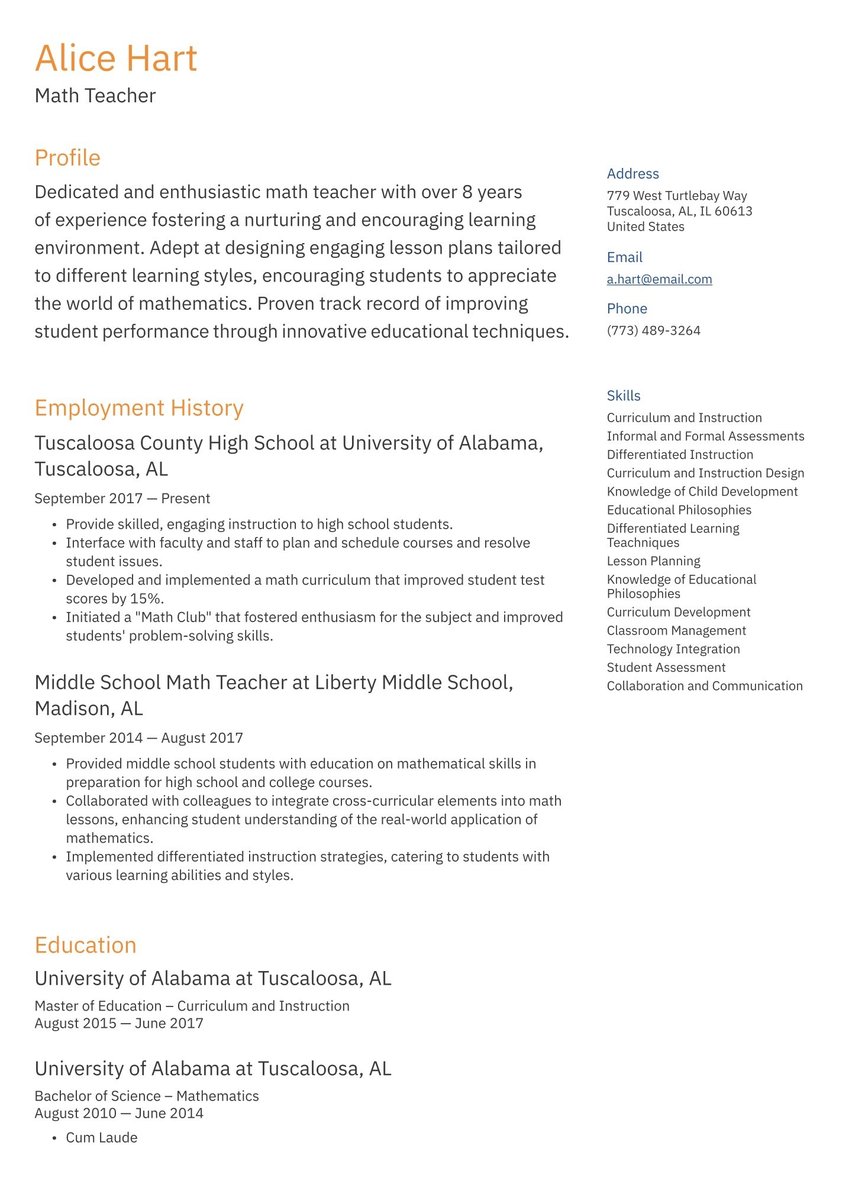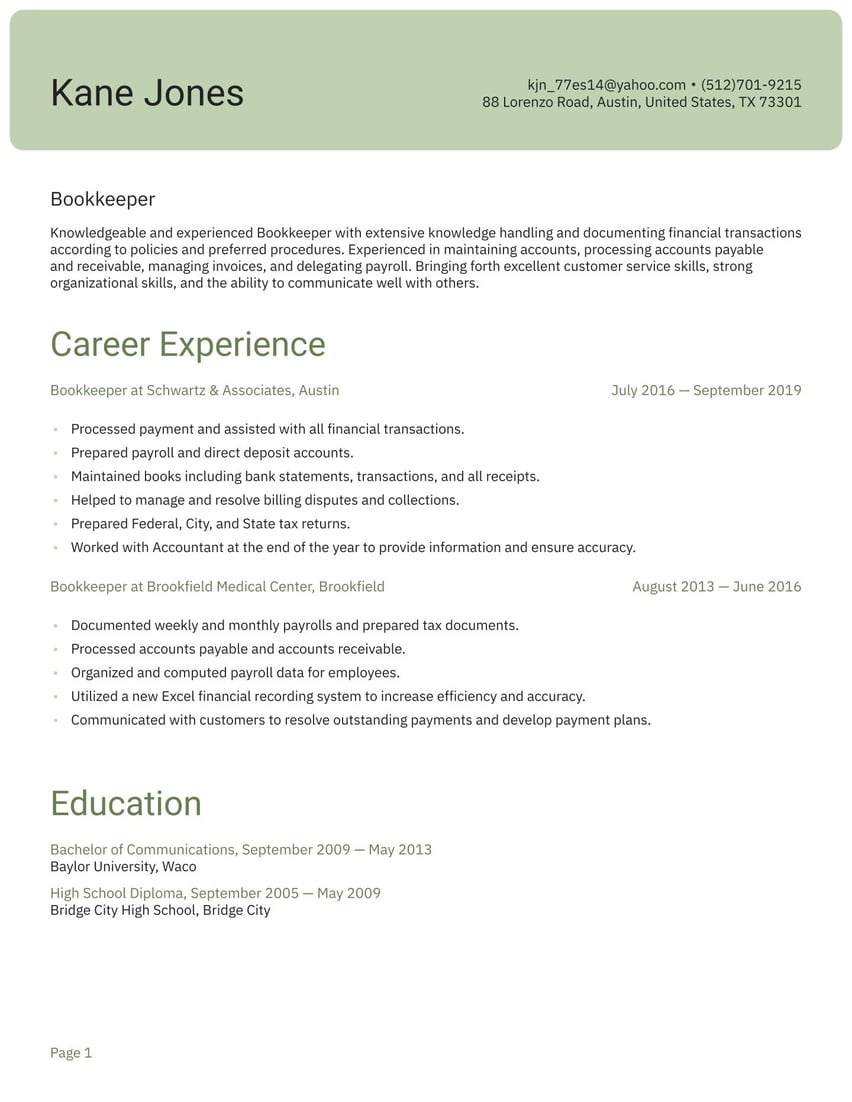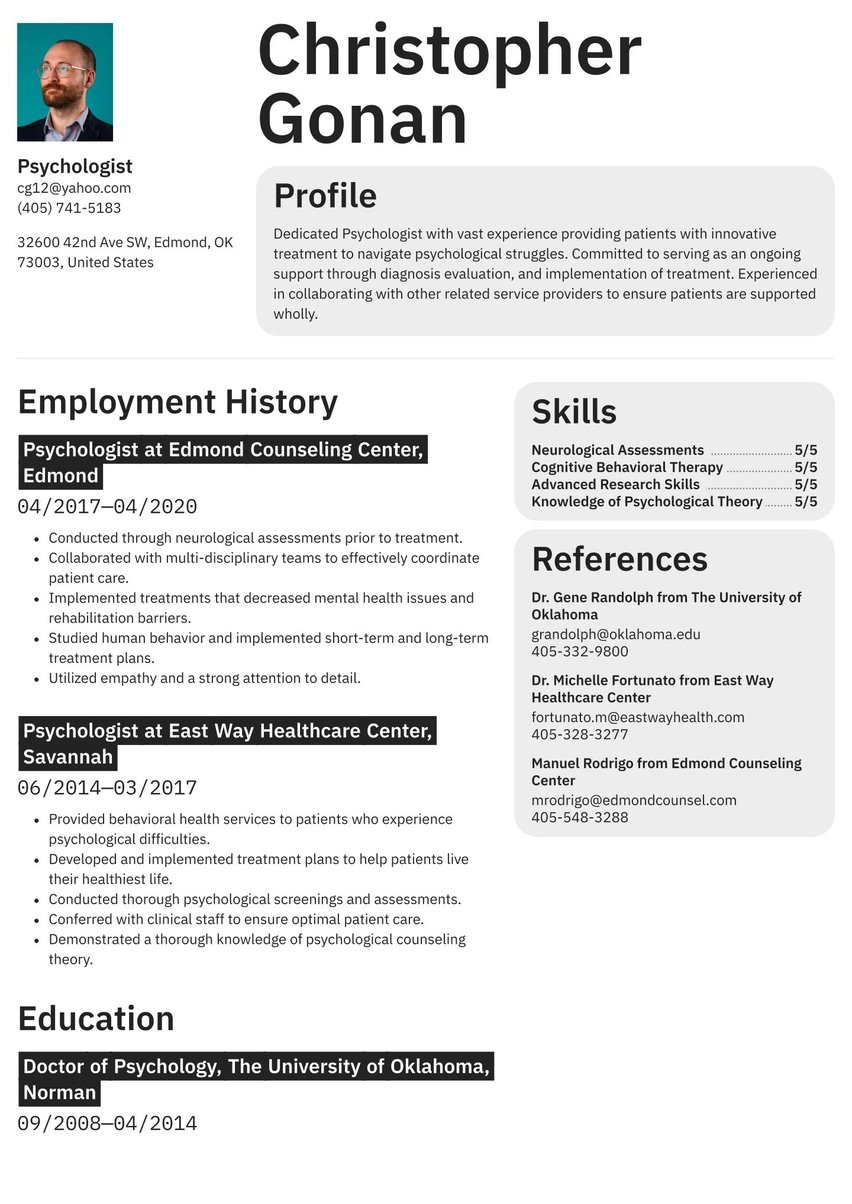The category visual artist encompasses a wide range of skills and talents. You may be an animator or a sculptor, a graphic designer or a fine arts expert. You may be multi-talented. In any case, you need to paint your skills in the best possible light. Whether you are looking for a full-time artist job or a new commission, you need a great resume to catch the eye of your next client or company.
Visual Artist resume examples by experience level
Of course, you have a portfolio of your work. The good news is that you can link to it directly from Resume.io. You can get additional ideas by taking advantage of our dedicated resume builder tool, resume examples, and the helpful tips within this guide that focus on:
- What do visual artists do?
- The structure for a visual artist resume
- How to choose the best format for a visual artist resume
- What to include in the summary, employment history, education, and skills sections of your resume
- And we know you’re an artist, but you still may want to know the boundaries for creating an eye-catching and professional layout and design.
What does a visual artist do?
Anywhere there are images, color, graphics, textile design – anything visual – there’s a visual artist. They work in media such as paint, sculpture, ceramics, video, photography, or anything else they can imagine.
Visual artists may be hired by companies to create advertising materials, design packaging, or even create art to decorate their headquarters and other spaces where employees work and clients and customers visit. They may create aspects of video games such as the characters or settings.
Some visual artists work for themselves and have gallery representation and exhibitions in which they hope to sell their work or take individual commissions to create works of art. They may also work in museums, in publications that use visual arts, as cinematographers or anywhere else that contains an important visual component.
Visual artist job outlook and income
Visual artists don’t have a single, or straight, career path. Because their talents can take them in so many different directions, it is difficult to pinpoint the job market or income level they can expect.
A pre-pandemic survey found that nearly 60 percent of artists reported earning less than $30,000 from their artwork while 7 percent earned more than $70,000. Many artists reported having part-time jobs to supplement their income. The survey also found that freelance work was many artists’ greatest source of income.
Some artists sell their work online, teach classes, or find other creative ways to continue to make art.
How to write a visual artist resume
Visual artists think outside the box – after all they are creative. But keep your creativity within bounds when you develop your visual artist resume.
To that end, your visual artist CV should contain the following standard elements:
- The resume header
- The resume summary (aka artist statement or profile)
- The employment history section
- The resume skills section
- The education section
The main goal of your resume is to get the interview or commission. To do that, you must make it easy for clients or hiring managers to find relevant information (and the link to your portfolio). Maintaining a familiar structure accomplishes that.
References
Your reputation as an artist is key to your ability to get more work. You may want to add a separate section for references, or compile a page complimentary to your resume that you can offer to potential employers or clients.
Choosing the best resume format for a visual artist
The format, or structure, of your visual artist resume is not the place to get creative. Save that for your design and portfolio. Your goal here is to present your work history or commissions and clients in an organized fashion.
We usually recommend reverse chronological order, in which you begin with your most recent job and work your way back up to ten years; however, if you are a freelancer or commissioned artist, you may want to develop a list of clients with a short description of the work you completed. You can list these in reverse chronological order or in order of scope and importance, if that showcases your work better.
If you have had more typical long-term employment, stay traditional. Otherwise, you may also consider one of the alternate formats we suggest.
Profile or artist statement example
For most professions, this section would be a professional profile, and you can still choose to, but include your visual arts style. If you include an artist statement in your visual artist resume instead, explain your artistic philosophy and include the styles and media in which you work.
You may also want to mention your artistic influences. The fundamentals are similar to building a personal statement, but with additional artistic factors explained.
For either a resume summary profile or artist statement, you should highlight your greatest achievements, whether it be commissions, solo exhibitions, or a work for an employer. If you have earned any awards for your art or had a piece chosen for a juried exhibition, definitely include that!
The bottom line for a profile or artist statement is to give recruiters an idea of who you are and how you work. Remember that every client is a customer and you want to describe your collaborative process so that they understand how you will work together. You may include a great interaction with a previous client or a sentence on how you work in a team. If space is getting tight (your resume should be no more than two pages at the most), consider adding more details into your cover letter.
For more resume examples to guide you through this most challenging section, see our 3D animator resume sample, motion graphics artist resume example, photographer resume sample, graphic designer resume example and tattoo artist resume sample.
Dedicated Visual Artist with a decorated background in a variety of artistic mediums. Highly experienced in illustration and animation. Adept at working independently and collaboratively on projects and committed to achieving visual innovation and beauty. Ability to work well with others and utilize my art skills to visually enhance projects.
Employment history sample
Your employment history section may look very different from a 9-to-5er’s section. If you have had steady, full-time work, use reverse chronological order in your visual artist resume; however, if you are self-employed, list your work by project and include a sentence or two on the project specifications.
Either way, use bullet points to describe your artistic creations or achievements. Use strong descriptions and action verbs to convey a candidate’s ability to create works of art using specific artistic mediums such as drawing, painting, sculpture, textile design and so on. Also include the idea, emotion, message, or information your work expressed.
If you have held other jobs, focus on positions with transferable skills for a Visual Artist position.
Illustrator at Neon Magazine, Los Angeles
April 2014 — Present
- Utilize Photoshop and Illustrator in combination with traditional tools to create and enhance illustrations.
- Create hand-drawn inspiration boards using advanced technical drawing skills.
- Consult with clients and art directors regarding all visual content.
- Work to effectively prioritize project goals and stick to important timelines regarding projects.
- Use various art techniques to effectively convey ideas, emotions, tones, and stories.
Cartoonist at The Other Daily Paper, Los Angeles
May 2010 — March 2014
- Created cartoons to accompany editorial projects.
- Commonly created political and social illustrations.
- Animated characters using advanced software to place cartoons into motion.
- Worked collaboratively with other departments to ensure a smooth publication process.
Visual artist resume education example
Although there are typically no education or training requirements required for a visual artist position, certain companies may require or prefer formal training or an advanced degree such as a master of fine arts. Your visual artist resume should highlight any formal experience and training you have.
It is helpful for a professional visual artist to have some kind of formal training in the fundamentals of form, color and composition, and various art techniques. Remember to include any software training, such as Adobe Illustrator, InDesign, or any other skill related to your work.
List all degrees and certifications here. Any awards, honors, or distinctions should be noted here as well. If you hold a degree higher than a bachelor’s degree, you may leave out your high school diploma.
Bachelor of Animation, Pepperdine University, Malibu
August 2005 — May 2009
High School Diploma, Malibu High School, Malibu
September 2001 — May 2005
CV skills example
The skills section of your visual artist resume comprises a list of 5-10 of your abilities both as an artist and as a collaborator. It is particularly important because recruiters or potential clients will be looking for artists with specific abilities and they want to be able to see them at a glance.
Every time you apply for a new job, you should match the requirements of the position with the skills you have listed here. Once again, remember that your artistic talent is very important, but so is your ability to keep a schedule, stay organized, and work with others to create the finished product they envision.
Most employers use an Applicant Tracking System that scans your resume for specific keywords, phrases, and other pertinent information. The better your resume matches the job listing, the more likely it is you will pass this computerized test.
Your degree of talent and skill is especially important when it comes to finding work as an artist.
- Advanced Technical Drawing Skills
- Animation Techniques
- Stop Motion
- Interactive Media Skills
- Knowledge of Adobe Photoshop, After Effects, and Illustrator
- Project Management Skills
- Creative Problem Solving Skills
Resume layout and design
You’re an artist, so you may be tempted to get very creative here and that’s great; however, you have to remember your objective: Your resume has to be easily scanned. You may choose to use our creative resume templates as a jumping-off point or apply your skills to your own design, but keep these points in mind:
- Make sure your contact information is obvious. You won’t get the job if your prospective employer can’t find your phone number.
- Keep the font legible.
- Go easy on the bright colors.
- Make sure your section headings stand out.
- Include any social media accounts that highlight your work in your contact information heading unless you have many. Then, consider a separate area for them.
Creative workers are the only ones who we recommend should use a profile photo. Your personal look is part of your image as a visual artist. Your resume should also contain a link to an online portfolio (which you can do using our resume builder tool), showcasing your visual works and important information.
Key takeaways for a visual artist resume
- The careers of visual artists may take many forms and may be conducted in a host of disparate environments, but their commonality is a creativity people can see.
- A creative statement on your visual artist resume gives prospective clients and employers an overview of your philosophy and style.
- The format of your employment history section depends on the course of your career.
- Visual artists have many opportunities to earn a living from their work and a well-targeted resume can make all the difference in getting that next commission.


.jpg)

.jpg)
